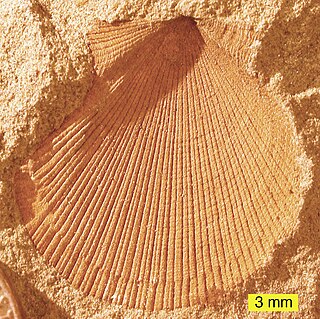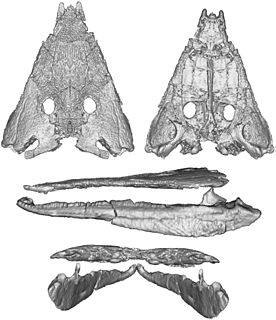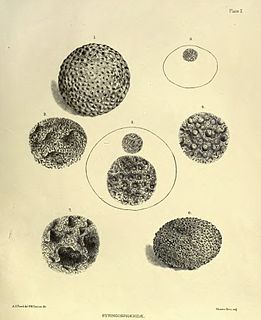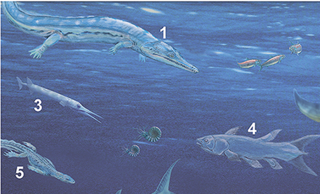 W
WAdelobasileus is a genus of mammaliamorph cynodonts from the Late Triassic (Carnian), about 225 million years ago. It is known only from a partial skull recovered from the Tecovas Formation in western Texas, southern United States, referred to the species Adelobasileus cromptoni.
 W
WAndescynodon is a genus of traversodontid cynodonts from the Middle Triassic of Argentina. Fossils are known from the Cerro de las Cabras and Cacheutá Formations. Andescynodon is one of the most basal traversodontids. Another traversodontid called Rusconiodon has also been identified from the Cerro de las Cabras Formation but is now considered a junior synonym of Andescynodon.
 W
WAntrimpos is an extinct genus of crustacean which existed during the Triassic and Jurassic periods. It contains 15 species, including Antrimpos speciosus.
 W
WAphaneramma is an extinct genus of marine temnospondyl amphibian. It lived during the Early Triassic epoch. Fossils have been found in the Mianwali Formation of Pakistan, Madagascar, the Zhitkov Formation of Russia, and the Kongressfjellet Formation of Svalbard (Norway).
 W
WAraxoceratidae is an extinct family of ceratitid ammonites, cephalopods that were found throughout the world. They arose during the Permian and died out during the early Triassic. The species of the type genus Araxoceras are used as markers for various Permian epochs.
 W
WAustrolimulus fletcheri is an extinct xiphosuran, related to the modern horseshoe crab. The holotype and only known specimen is from Middle Triassic-aged strata of Brookvale, New South Wales of Australia.
 W
WAviculopecten is an extinct genus of bivalve mollusc that lived from the Early Devonian to the Late Triassic in Asia, Australia, Europe, North America, and South America.
 W
WAxitectum is an extinct genus of bystrowianid reptiliomorph from lower Triassic deposits of Nizhni Novgorod and Kirov Regions, Russia. It was a rather large animal judging by the size of its vertebrae. The back was covered in bands of highly ornamented osteoderm plates, similar to those found in modern crocodiles. The bands overlapped with the next band at the posterior end.
 W
WBatrachosuchus is a genus of temnospondyl amphibian that existed from the Early to Middle Triassic of Southern Africa and the Blina Shale of Australia.
 W
WBoreopelta is an extinct genus of rhytidosteid temnospondyl from the early Triassic period of Yakutsk Region, central Siberia, Russia. It is known from the holotype PIN 4115/1, a skull fragment and from the referred specimen PIN 4113/5, a partial lower jaw, recovered from the Teryutekhskaya Formation near the Karya-khos-Teryutekh River. This genus was named by M. A. Shishkin and M. N. Vavilov in 1985, and the type species is Boreopelta vavilovi.
 W
WBrachyopomorpha is a clade of stereospondyl temnospondyls within the infraorder Trematosauria. It was constructed in 2000 to include Bothriceps australis and the superfamily Brachyopoidea. It is phylogenetically defined as a stem-based taxon including Pelorocephalus and all taxa closer to it than to Rhytidosteus. In contrast, Brachyopoidea is defined as a node-based taxon including Brachyops and Pelorocephalus and all descendants of their most recent common ancestor. Because Bothriceps is not thought to be a descendant of that recent common ancestor and would be more basal than it, the genus is placed just outside Brachyopoidea and is considered to be a sister taxon to the clade.
 W
WBystrowiella is an extinct genus of bystrowianid reptiliomorph from upper Middle Triassic deposits of Kupferzell and Vellberg, northern Baden-Württemberg, Germany. It was first named by Florian Witzmann, Rainer R. Schoch and Michael W. Maisch in 2008, from a complete osteoderm fused with tip of neural spine, partial osteoderms and vertebrae. The type species is Bystrowiella schumanni. The genus is named in honour of Dr. Alexey Bystrow, a Russian paleontologist and the species in honour of Schumann family. Bystrowiellas closest relative was Synesuchus.
 W
WCalmasuchus is a genus of capitosaurian temnospondyl which lived during the middle Triassic. Fossils of Calmasuchus have been recovered from the La Mora site of the Catalan basin in Barcelona of Spain. Identified from a partial skull roof and palate, skull fragments and complete hemi-mandible, it was named by Josep Fortuny, Àngel Galobart and Carles De Santisteban in 2011. The type species is Calmasuchus acri.
 W
WCaloneurodea is an extinct order of polyneopteran neopteran insects in the superorder Orthopterida.
 W
WCapitosaurus is an extinct genus of temnospondyl amphibians whose remains have been found in Spitsbergen and Germany. Its skull was 30 cm long, with a total length over 122 cm. Several species have been assigned to the genus over the years, but only the type species C. polaris is still valid today.
 W
WCeratites is an extinct genus of ammonite cephalopods. These nektonic carnivores lived in marine habitats in what is now Europe, during the Triassic, from the upper-most Anisian to the lower Ladinian age.
 W
WChainosauria is a large clade of anomodont therapsids. It includes dicynodonts, dromasaurians and the basal taxon Patranomodon.
 W
WCherninia is an extinct genus of mastodonsaurid temnospondyl. The type species, Cherninia denwai, is known from the Denwa Formation of India. It is based on a massive skull, ISI A 54, which was originally considered a species of Parotosuchus in 1998 before being given its own genus in 2001.
 W
WThe Chroniosuchidae are a family of semi-aquatic reptiliomorph amphibians found in sediments from the upper Permian and the upper Triassic periods, most in Russia. They were generally rather large animals, with long jaws similar to those found in modern crocodiles, and probably lived a similar life style as riverside piscivores and ambush predators. Like all Chroniosuchians, they bore extensive osteoderm armour on their backs, possibly as protection against terrestrial predators such as the Permian therapsids and the Triassic Rauisuchians.
 W
WClaraia is an extinct genus of scallop-like bivalve molluscs that lived from the Capitanian stage of the Late Permian to the Anisian stage of the Middle Triassic, 266-237 million years ago. Fossils have been found worldwide in North America, Europe, Asia, Africa, and Australia. These are common fossils subsequent to the Permian-Triassic boundary, suggesting that the genus experienced rapid diversification during and after the Permian–Triassic extinction event, around 251.4 million years ago.
 W
WCompsocerops is an extinct genus of temnospondyl amphibians recovered from the Late Triassic Upper Maleri Formation of India, and the Santa Maria Formation of Brazil.
 W
WDerwentia is an extinct genus of trematosaurian temnospondyl within the family Rhytidosteidae. It is known from a single skull found from the Knocklofty Sandstone of Tasmania, which is Early Triassic in age.
 W
WForeyia is an extinct genus of coelacanth lobe-finned fish which lived during the Middle Triassic period in what is now Canton of Graubünden, Switzerland. It contains a single species F. maxkuhni.
 W
WGigatitan is an extinct genus of titanopteran insect that lived in Kyrgyzstan during the Triassic period. The type species is G. vulgaris, described by Aleksandr Grigorevich Sharov in 1968. Fossils of Gigatitan have been found in the Madygen Formation. In life, Gigatitan was a mantis-like predator with a wingspan of approximately 33 centimetres (13 in). Its forelimbs were similarly enlarged and bore spines for prey capture. The ovipositor of Gigatitan bore sharp cutting ridges. These were likely used to excise holes in plant matter for oviposition, similar to some modern Orthoptera. It is the type genus of the family Gigatitanidae, in which the closely related Nanotitan and Ootitan are also included.
 W
WHeterastridium is an extinct genus of marine hydrozoan. It is the only accepted genus in the monotypic family Heterastridiidae. The fossils date from the Upper Triassic. They are mostly discoid or spherical and some forms found in the Karakorum mountains are called Karakorum stones. They vary in diameter from 1 to 35 cm and appear to follow Cope's rule for the prehistoric climate.
 W
WThe Mastodonsauroidea are an extinct superfamily of temnospondyl amphibians known from the Triassic and Jurassic. Fossils belonging to this superfamily have been found in North America, Greenland, Europe, Asia, and Australia. The genus Ferganobatrachus is included in this superfamily but not placed in any of the included families.
 W
WPolonodon is an extinct genus of dromatheriid cynodonts that lived in what is now Poland during the Carnian stage of the Late Triassic. It includes one species, Polonodon woznikiensis, which is known only from isolated teeth.
 W
WRamonalinidae is an extinct family of marine bivalve molluscs from the late Anisian. It was an edgewise-recliner with a flattened anteroventral surface and partially fused valves. They formed distinctive mud mounds.
 W
WShansiodon is a genus of dicynodont from Middle Triassic of China and South Africa.
 W
WSinokannemeyeria is a genus of kannemeyeriid dicynodont that lived during the Anisian age of Middle Triassic period in what is now Shanxi, China.
 W
WSpiriferina is an extinct genus of brachiopods that lived from the Late Silurian to the Middle Jurassic in Asia, Europe, North America, South America, and New Zealand.
 W
WTicinepomis is an extinct genus of coelacanth lobe-finned fish which lived during the Middle Triassic period in what is now Switzerland. It contains a single species, T. peyeri. T. peyeri specimens are most common in the Besano Formation of Monte San Giorgio in Ticino. Other coelacanths from Monte San Giorgio include a larger species from the Besano Formation, and a species of Heptanema from the Meride Limestone. Larger Ticinepomis specimens have been found in the Prosanto Formation of Graubünden.
 W
WTitanoptera is an extinct order of neopteran insects from late Carboniferous, Permian, and Triassic periods. Titanopterans were very large in comparison with modern insects, some having wingspans of up to 36 centimetres (14 in).
 W
WTraversodontidae is an extinct family of herbivorous cynodonts. Traversodonts were primarily Gondwanan, with many species known from Africa and South America. Recently, traversodonts have also been found from Europe and eastern North America. Traversodonts first appeared in the Middle Triassic and diversified in the Late Triassic before going extinct at the end of the epoch. The family Traversodontidae was erected by Friedrich von Huene in 1936 for cynodonts first found in São Pedro do Sul in Paleorrota, Brazil.
 W
WWantzosaurus was a genus of temnospondyl amphibian of the Trematosauridae family. Fossils have been found in the Early Triassic Middle Sakamena Formation of what is now Madagascar. It showed adaptations for an almost completely aquatic lifestyle, having the ability to swim by lateral undulation. A pelagic lifestyle for this animal has been proposed.
 W
WWetlugasaurus is an extinct genus of temnospondyl amphibian from the Early Triassic (Olenekian) Charkabozh, Kzylsaiskaya, Petropavlovka, Kamennyi Yar and Vetluga Series Formations of northern Russia and Greenland. It had a 22 centimetres (8.7 in) long skull, and reached a total length of 1 metre.
 W
WXenacanthida is an order of prehistoric sharks that appeared during the Lower Carboniferous period. The order includes the families Xenacanthidae, Diplodoselachidae, and Orthacanthidae. The most notable members of the group are the genera Xenacanthus and Orthacanthus. Some Xenacanthida may have grown to lengths of 5 m (16 ft). Most forms had large serrated spines extending backwards from the neck. Xenacanthus had characteristic teeth. Most xenacanths died out at the end of the Permian in the Permian Mass Extinction, with only a few forms surviving into the Triassic period. They were native to freshwater, marginal marine and shallow marine habitats.